Phylum Cnidaria – Basics
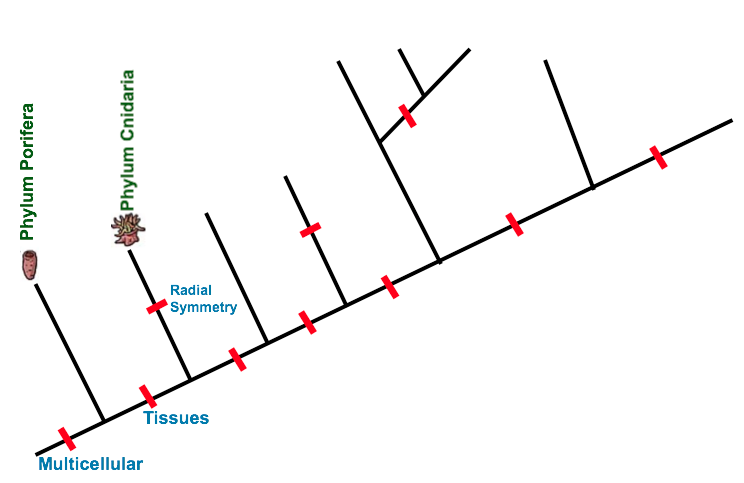 Cnidaria -> “Nettle” “Bearing”
Cnidaria -> “Nettle” “Bearing” - Appearing ~580 million years ago (Although new genetic evidence suggests cnidarians are older)
- Most have life cycles that include two stages:
-
- 1. “Sessile” polyp (non-motile – stuck in one spot)
- 2. “motile” medusa (Free swimming)
- Aquatic

A. Evolution of Body Plan
- Cnidarians have two body plans:
- Polyp: A sessile form with mouth and tentacles facing upward. Ex. corals, sea anemone)
- Medusa: Free-floating (planktonic) form. Looks like a bell with tentacles and mouth facing downward. (Jellies)
2. Body has two cell layers (ectoderm and endoderm) separated by a layer of jelly-like “mesoglea”
This is considered a primitive tissue. Ectoderm -> Outer skin. Endoderm -> Inside skin.
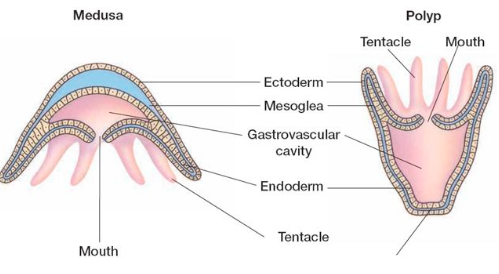
- Radial Symmetry – Symmetry around a central axis.
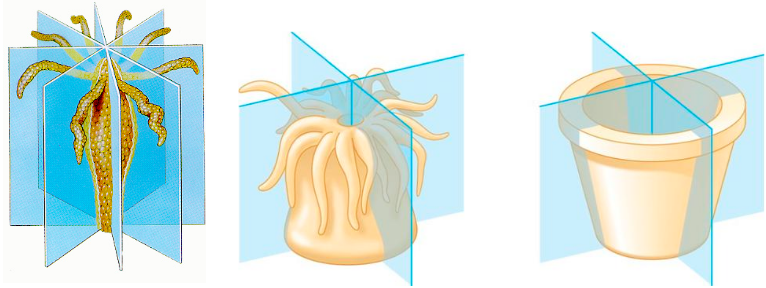
B. Feeding and Excretion
- Carnivores that depend on prey coming into contact with their stinging tentacles.
- Tentacles surround the mouth – which leads to a gastrovascular cavity for digestion.
- Two-way digestive system – This means food and waste enter/exit from the same opening
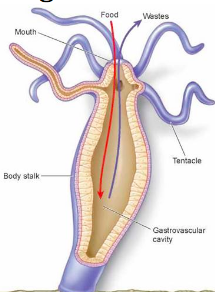
How do tentacles catch prey?
- Tentacles are covered with special cells called cnidocytes
- Inside each cnidocyte there is a spring-loaded spear called a nematocyst
- The group gets its name for these stinging cells! It is the most important defining feature.
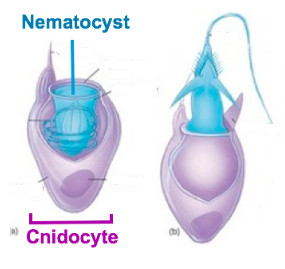
Process:
- The tentacle comes into contact with the prey.
- Physical and chemical cues cause the nematocyst to shoot out and stick into the prey – delivering the venom and causing prey to be stuck
- Tentacles contract, bringing the prey to the mouth
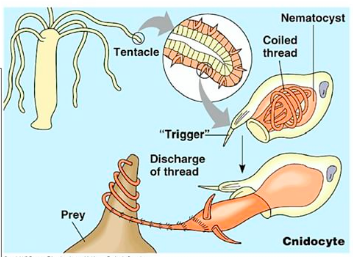
C. Respiration and Circulation
- Just like sponges, no organs/systems to perform these functions.
- Gas exchange occurs through diffusion (O2 in, CO2 out). Based on concentration outside/inside the cells – movement from higher concentration to lower concentration.
D. Reproduction
Both sexual and Asexual reproduction!
Sexual Reproduction
- Sexual reproduction: External fertilization. Males and females “broadcast” their gametes (sex cells) into the ocean. Eggs and sperm meet and develop into a planula (larvae).
- These planktonic planula will attach to a surface and develop into a polyp or stay as a free-floating medusa.
Asexual reproduction
1. Asexual reproduction through budding.

2. Strobilation
- A polyp grows a stack of medusa clones which swim away (Jellies)
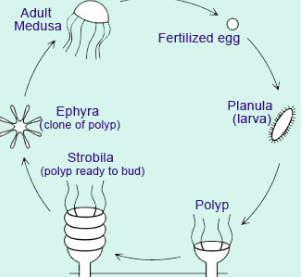
Note:
Most cnidarians cycle between medusa and polyp body plans.
Polyps typically reproduce asexually. Strobilation leads to free swimming medusa.
Medusa sexually reproduce. Planula develop and attach to a surface (Polyp)
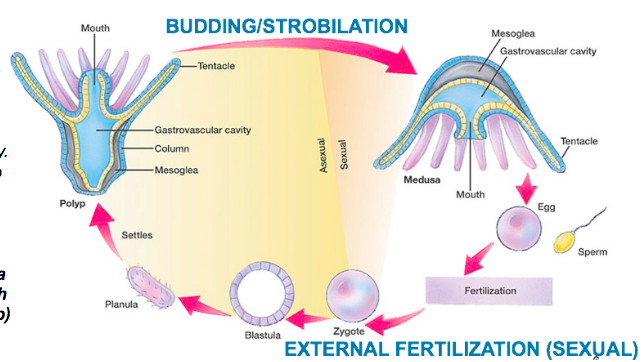
E. Major Groups

Class Cubozoa (Box Jellies)
- Active/deadly hunters – usually powerful venom that can kill humans.
- Have a special flap called a “vellum” which helps them swim quickly.
- Box shaped
- Have specialized “eyes” that help them hunt
Class Scyphozoa (True Jellies)
- Solitary (not colonial)
- Free swimming medusa form with reduced or absent polyp stage
- Sexualy reproduction commong in medusa.
Class Anthozoa (Anemones and Coral)
- Solitary or colonial
- Adults are sessile (non-motile)
- Only polyp phase, no medusa.
- Polyp performs sexual reproduction
Class Hydrozoa (Hydra/Portuguese Man o’ War)
- Use your pre-lab:)
Extra: Jellyfish as food
- As we release more CO2, our ocean becomes more acidic.
- Animals (such as molluscs) struggle in this environment and are in trouble.
- Jellyfish will rule the seas!
- Jellyfish numbers are increasing in many places!

Jellyfish abound, and may be coming to a dinner plate near you
Jellyfish Salad – Basics (Ask for the full recipe or check out some others!) I bought the jellyfish we ate at T&T Marine Drive 🙂
- Get a group of about 5 – collect a mixing bowl, small bowl, cutting board, and scissors.
- Follow the recipe: below is a fast breakdown.
- Cut jellyfish into strips – pour boiling water then cold water over.
- Mix up sauce.
- Add veggies to jellyfish.
- Put on sauce (or whatever – just chili sauce? OK! Just soy sauce? Go for it!)
- Save the oceans and eat the mesoglea!
Additional Review Questions
- What is the defining feature of cnidarians? (Hint: Think about their name and the type of cell they use to hunt)
- Draw and label a diagram of the typical life cycle of a cnidarian. Include a medusa and a polyp phase. (Include the terms: strobilation, external fertilization, planula, medusa, and polyp)
- How many cell layers do cnidarians have? What are these called? What is in between them?
- Describe a two-way digestive system found in cnidarians.
- Compare sponges to cnidarians. What do they have in common? What differences?
- Describe the complete feeding process in cnidarians (from catching to eating to getting rid of waste). Be sure to include as much detail as you can including the cells involved and their mechanism.
Comments by shaun pletsch